Human Resource Management for Service Industries: A Case Study
VerifiedAdded on 2023/01/19
|17
|4424
|31
Report
AI Summary
This report provides a comprehensive analysis of Human Resource Management (HRM) within the service industry, using British Airways as a case study. It begins by defining the role and purpose of HRM, including recruitment and selection, development of organizational culture, training and development, employee relations, and budget management. The report then examines British Airways' current employment relations, highlighting strategies to improve employee motivation and manage workplace conflicts. It also explores the impact of employment laws on HRM practices, emphasizing the importance of compliance with regulations such as employment rights acts and anti-discrimination laws. Further, the report includes an analysis of a cabin crew job description and the selection procedure for British Airways and Transport for London (TFL), followed by a discussion of training and development programs, their effectiveness, and their impact on operational activities. The report concludes by summarizing the key findings and emphasizing the importance of effective HRM for organizational success and sustainability.
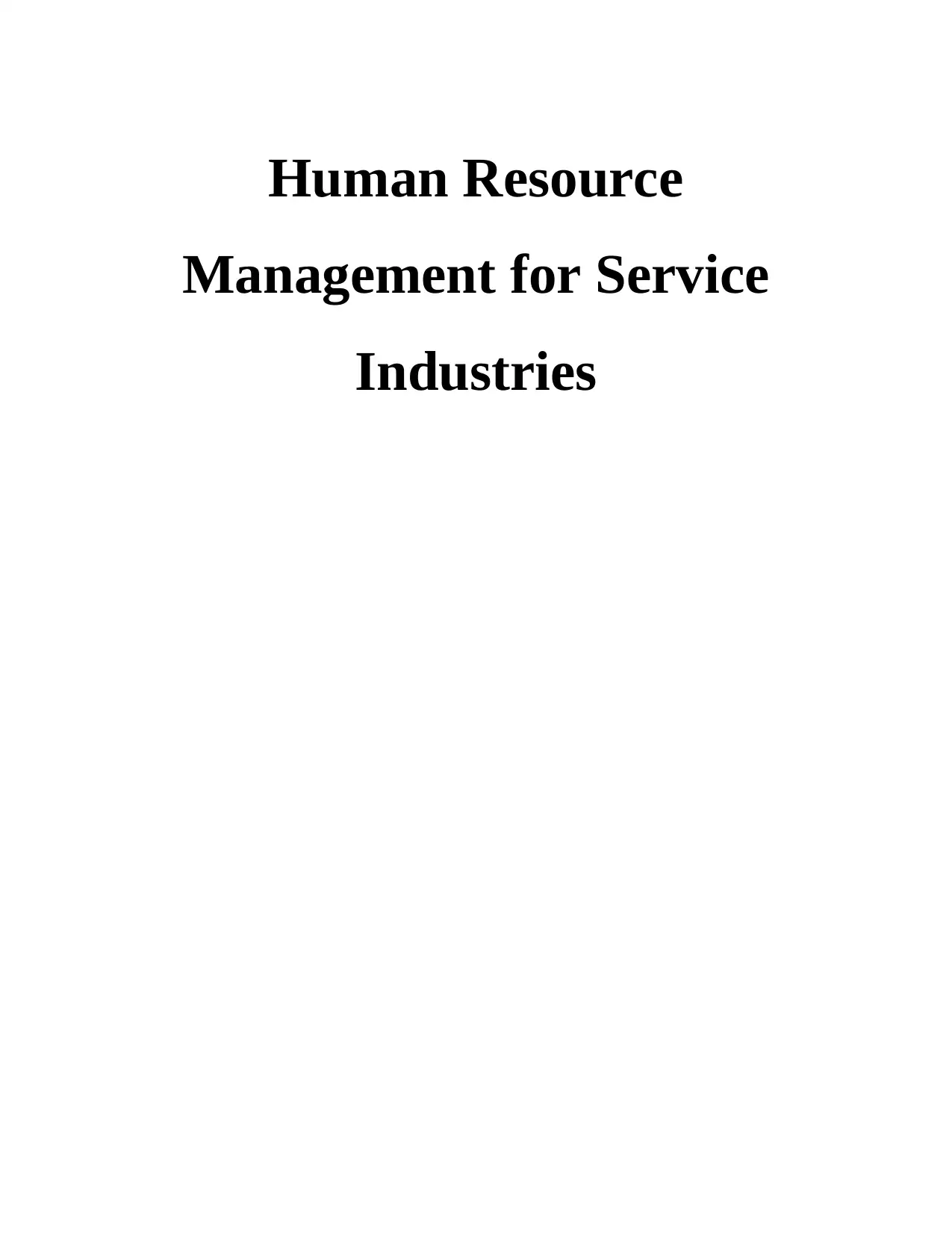
Human Resource
Management for Service
Industries
Management for Service
Industries
Paraphrase This Document
Need a fresh take? Get an instant paraphrase of this document with our AI Paraphraser
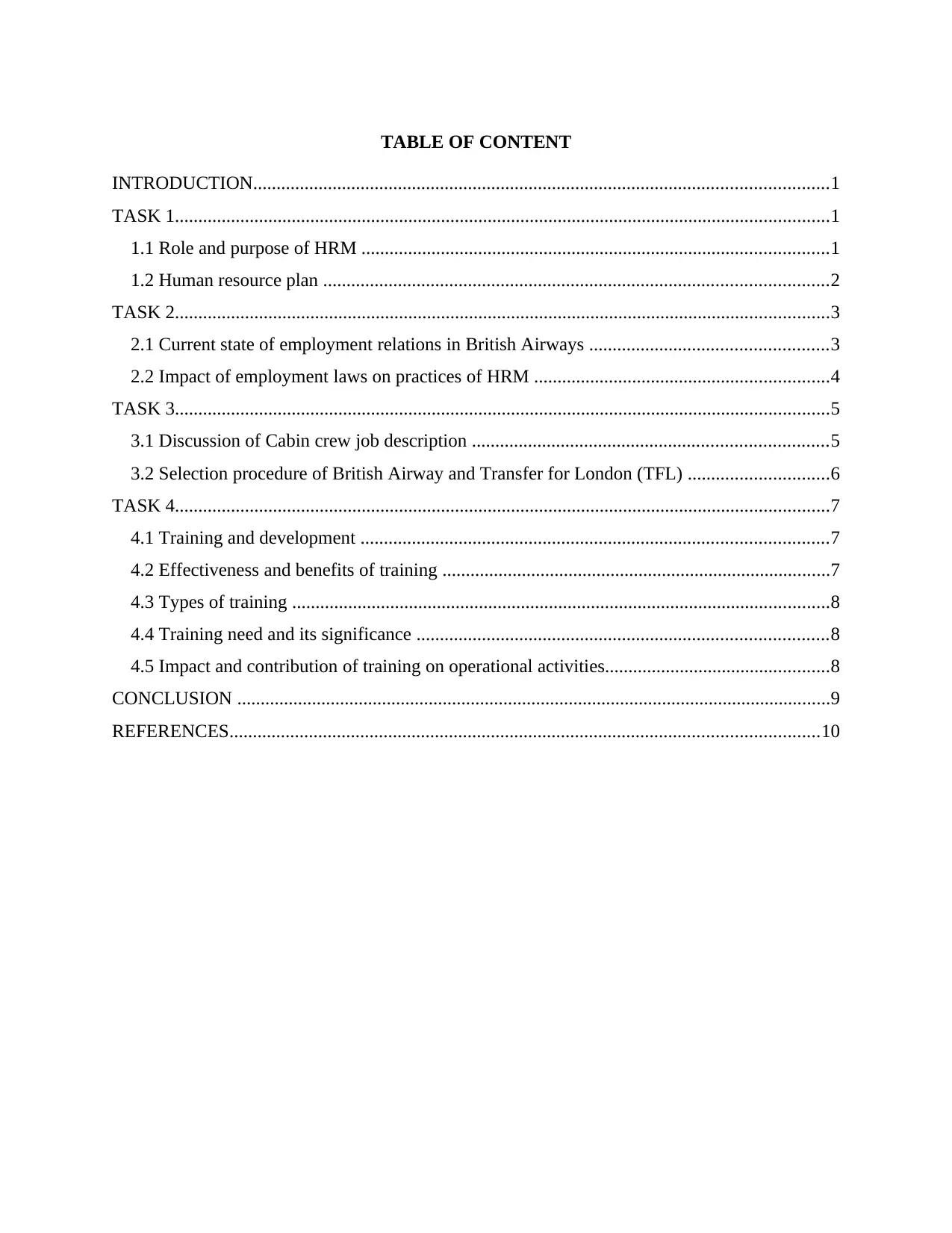
TABLE OF CONTENT
INTRODUCTION...........................................................................................................................1
TASK 1............................................................................................................................................1
1.1 Role and purpose of HRM ....................................................................................................1
1.2 Human resource plan ............................................................................................................2
TASK 2............................................................................................................................................3
2.1 Current state of employment relations in British Airways ...................................................3
2.2 Impact of employment laws on practices of HRM ...............................................................4
TASK 3............................................................................................................................................5
3.1 Discussion of Cabin crew job description ............................................................................5
3.2 Selection procedure of British Airway and Transfer for London (TFL) ..............................6
TASK 4............................................................................................................................................7
4.1 Training and development ....................................................................................................7
4.2 Effectiveness and benefits of training ...................................................................................7
4.3 Types of training ...................................................................................................................8
4.4 Training need and its significance ........................................................................................8
4.5 Impact and contribution of training on operational activities................................................8
CONCLUSION ...............................................................................................................................9
REFERENCES..............................................................................................................................10
INTRODUCTION...........................................................................................................................1
TASK 1............................................................................................................................................1
1.1 Role and purpose of HRM ....................................................................................................1
1.2 Human resource plan ............................................................................................................2
TASK 2............................................................................................................................................3
2.1 Current state of employment relations in British Airways ...................................................3
2.2 Impact of employment laws on practices of HRM ...............................................................4
TASK 3............................................................................................................................................5
3.1 Discussion of Cabin crew job description ............................................................................5
3.2 Selection procedure of British Airway and Transfer for London (TFL) ..............................6
TASK 4............................................................................................................................................7
4.1 Training and development ....................................................................................................7
4.2 Effectiveness and benefits of training ...................................................................................7
4.3 Types of training ...................................................................................................................8
4.4 Training need and its significance ........................................................................................8
4.5 Impact and contribution of training on operational activities................................................8
CONCLUSION ...............................................................................................................................9
REFERENCES..............................................................................................................................10
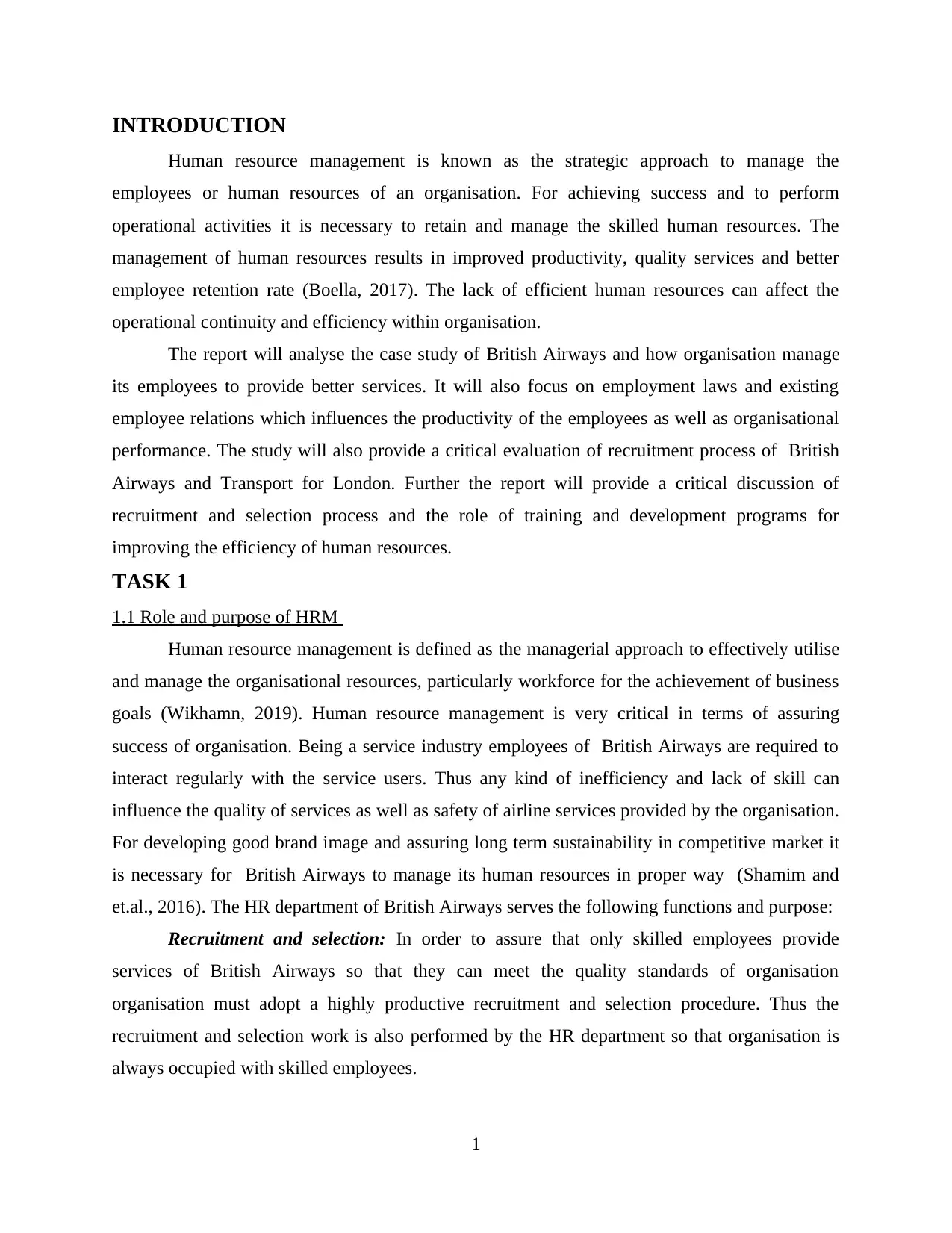
INTRODUCTION
Human resource management is known as the strategic approach to manage the
employees or human resources of an organisation. For achieving success and to perform
operational activities it is necessary to retain and manage the skilled human resources. The
management of human resources results in improved productivity, quality services and better
employee retention rate (Boella, 2017). The lack of efficient human resources can affect the
operational continuity and efficiency within organisation.
The report will analyse the case study of British Airways and how organisation manage
its employees to provide better services. It will also focus on employment laws and existing
employee relations which influences the productivity of the employees as well as organisational
performance. The study will also provide a critical evaluation of recruitment process of British
Airways and Transport for London. Further the report will provide a critical discussion of
recruitment and selection process and the role of training and development programs for
improving the efficiency of human resources.
TASK 1
1.1 Role and purpose of HRM
Human resource management is defined as the managerial approach to effectively utilise
and manage the organisational resources, particularly workforce for the achievement of business
goals (Wikhamn, 2019). Human resource management is very critical in terms of assuring
success of organisation. Being a service industry employees of British Airways are required to
interact regularly with the service users. Thus any kind of inefficiency and lack of skill can
influence the quality of services as well as safety of airline services provided by the organisation.
For developing good brand image and assuring long term sustainability in competitive market it
is necessary for British Airways to manage its human resources in proper way (Shamim and
et.al., 2016). The HR department of British Airways serves the following functions and purpose:
Recruitment and selection: In order to assure that only skilled employees provide
services of British Airways so that they can meet the quality standards of organisation
organisation must adopt a highly productive recruitment and selection procedure. Thus the
recruitment and selection work is also performed by the HR department so that organisation is
always occupied with skilled employees.
1
Human resource management is known as the strategic approach to manage the
employees or human resources of an organisation. For achieving success and to perform
operational activities it is necessary to retain and manage the skilled human resources. The
management of human resources results in improved productivity, quality services and better
employee retention rate (Boella, 2017). The lack of efficient human resources can affect the
operational continuity and efficiency within organisation.
The report will analyse the case study of British Airways and how organisation manage
its employees to provide better services. It will also focus on employment laws and existing
employee relations which influences the productivity of the employees as well as organisational
performance. The study will also provide a critical evaluation of recruitment process of British
Airways and Transport for London. Further the report will provide a critical discussion of
recruitment and selection process and the role of training and development programs for
improving the efficiency of human resources.
TASK 1
1.1 Role and purpose of HRM
Human resource management is defined as the managerial approach to effectively utilise
and manage the organisational resources, particularly workforce for the achievement of business
goals (Wikhamn, 2019). Human resource management is very critical in terms of assuring
success of organisation. Being a service industry employees of British Airways are required to
interact regularly with the service users. Thus any kind of inefficiency and lack of skill can
influence the quality of services as well as safety of airline services provided by the organisation.
For developing good brand image and assuring long term sustainability in competitive market it
is necessary for British Airways to manage its human resources in proper way (Shamim and
et.al., 2016). The HR department of British Airways serves the following functions and purpose:
Recruitment and selection: In order to assure that only skilled employees provide
services of British Airways so that they can meet the quality standards of organisation
organisation must adopt a highly productive recruitment and selection procedure. Thus the
recruitment and selection work is also performed by the HR department so that organisation is
always occupied with skilled employees.
1
⊘ This is a preview!⊘
Do you want full access?
Subscribe today to unlock all pages.

Trusted by 1+ million students worldwide
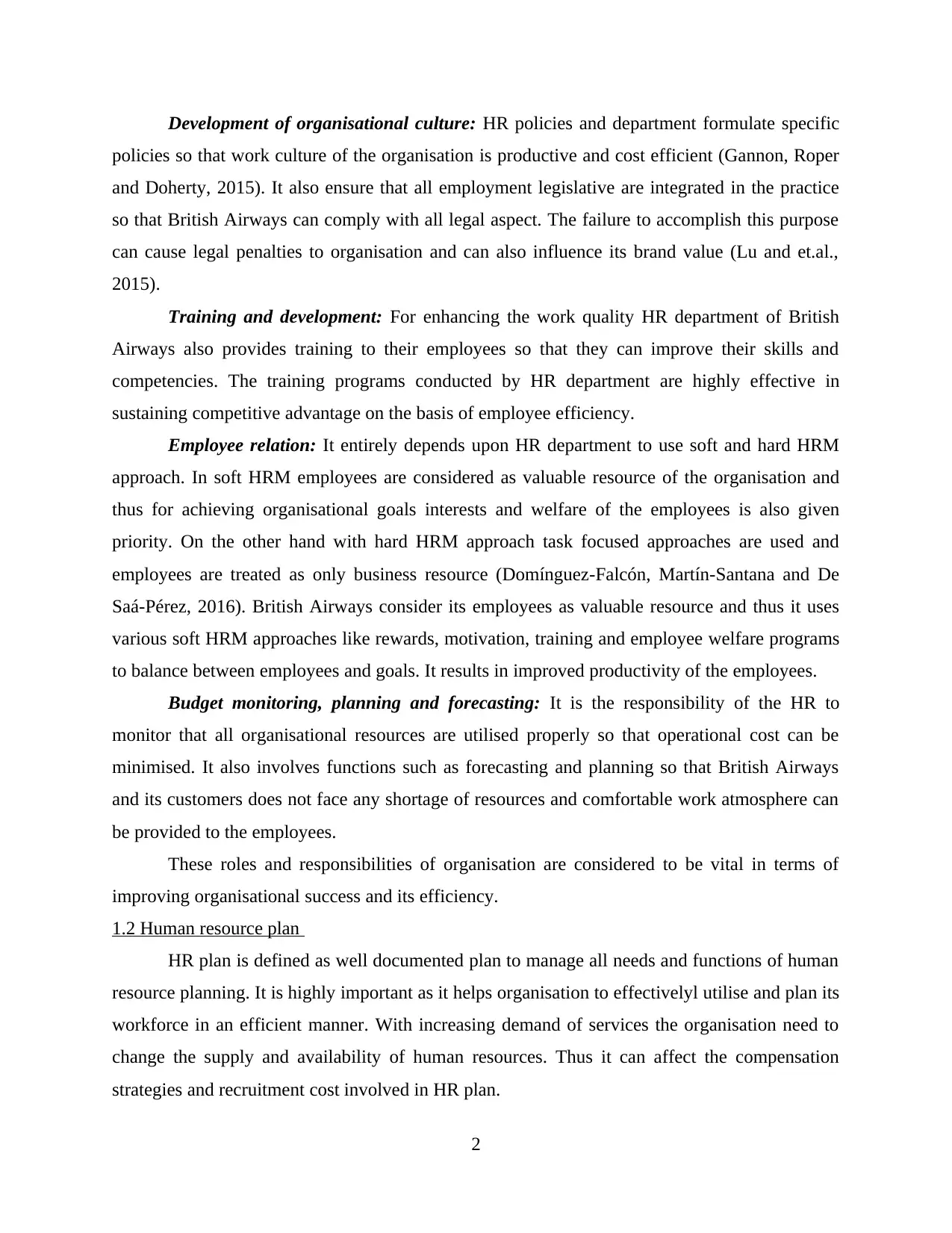
Development of organisational culture: HR policies and department formulate specific
policies so that work culture of the organisation is productive and cost efficient (Gannon, Roper
and Doherty, 2015). It also ensure that all employment legislative are integrated in the practice
so that British Airways can comply with all legal aspect. The failure to accomplish this purpose
can cause legal penalties to organisation and can also influence its brand value (Lu and et.al.,
2015).
Training and development: For enhancing the work quality HR department of British
Airways also provides training to their employees so that they can improve their skills and
competencies. The training programs conducted by HR department are highly effective in
sustaining competitive advantage on the basis of employee efficiency.
Employee relation: It entirely depends upon HR department to use soft and hard HRM
approach. In soft HRM employees are considered as valuable resource of the organisation and
thus for achieving organisational goals interests and welfare of the employees is also given
priority. On the other hand with hard HRM approach task focused approaches are used and
employees are treated as only business resource (Domínguez-Falcón, Martín-Santana and De
Saá-Pérez, 2016). British Airways consider its employees as valuable resource and thus it uses
various soft HRM approaches like rewards, motivation, training and employee welfare programs
to balance between employees and goals. It results in improved productivity of the employees.
Budget monitoring, planning and forecasting: It is the responsibility of the HR to
monitor that all organisational resources are utilised properly so that operational cost can be
minimised. It also involves functions such as forecasting and planning so that British Airways
and its customers does not face any shortage of resources and comfortable work atmosphere can
be provided to the employees.
These roles and responsibilities of organisation are considered to be vital in terms of
improving organisational success and its efficiency.
1.2 Human resource plan
HR plan is defined as well documented plan to manage all needs and functions of human
resource planning. It is highly important as it helps organisation to effectivelyl utilise and plan its
workforce in an efficient manner. With increasing demand of services the organisation need to
change the supply and availability of human resources. Thus it can affect the compensation
strategies and recruitment cost involved in HR plan.
2
policies so that work culture of the organisation is productive and cost efficient (Gannon, Roper
and Doherty, 2015). It also ensure that all employment legislative are integrated in the practice
so that British Airways can comply with all legal aspect. The failure to accomplish this purpose
can cause legal penalties to organisation and can also influence its brand value (Lu and et.al.,
2015).
Training and development: For enhancing the work quality HR department of British
Airways also provides training to their employees so that they can improve their skills and
competencies. The training programs conducted by HR department are highly effective in
sustaining competitive advantage on the basis of employee efficiency.
Employee relation: It entirely depends upon HR department to use soft and hard HRM
approach. In soft HRM employees are considered as valuable resource of the organisation and
thus for achieving organisational goals interests and welfare of the employees is also given
priority. On the other hand with hard HRM approach task focused approaches are used and
employees are treated as only business resource (Domínguez-Falcón, Martín-Santana and De
Saá-Pérez, 2016). British Airways consider its employees as valuable resource and thus it uses
various soft HRM approaches like rewards, motivation, training and employee welfare programs
to balance between employees and goals. It results in improved productivity of the employees.
Budget monitoring, planning and forecasting: It is the responsibility of the HR to
monitor that all organisational resources are utilised properly so that operational cost can be
minimised. It also involves functions such as forecasting and planning so that British Airways
and its customers does not face any shortage of resources and comfortable work atmosphere can
be provided to the employees.
These roles and responsibilities of organisation are considered to be vital in terms of
improving organisational success and its efficiency.
1.2 Human resource plan
HR plan is defined as well documented plan to manage all needs and functions of human
resource planning. It is highly important as it helps organisation to effectivelyl utilise and plan its
workforce in an efficient manner. With increasing demand of services the organisation need to
change the supply and availability of human resources. Thus it can affect the compensation
strategies and recruitment cost involved in HR plan.
2
Paraphrase This Document
Need a fresh take? Get an instant paraphrase of this document with our AI Paraphraser
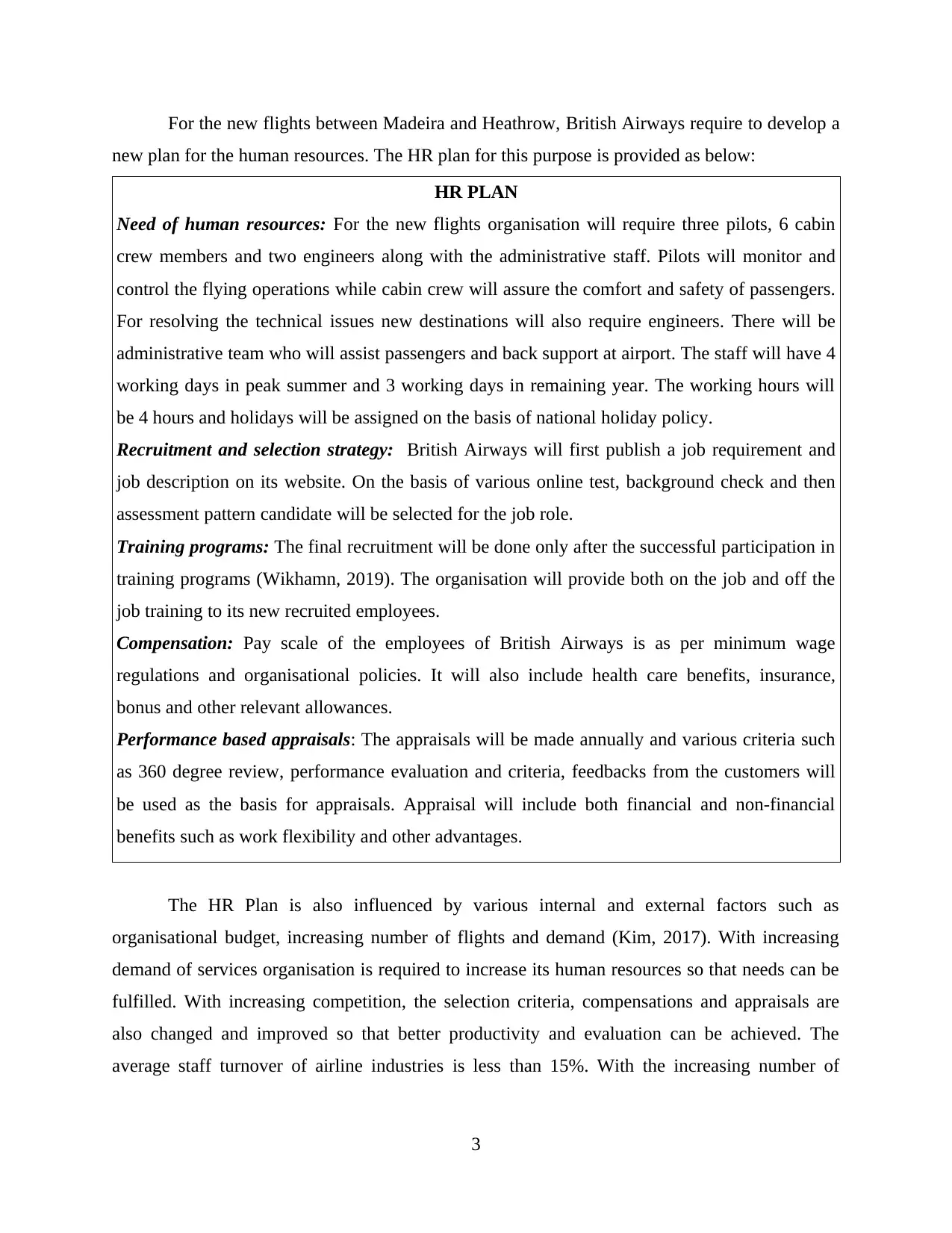
For the new flights between Madeira and Heathrow, British Airways require to develop a
new plan for the human resources. The HR plan for this purpose is provided as below:
HR PLAN
Need of human resources: For the new flights organisation will require three pilots, 6 cabin
crew members and two engineers along with the administrative staff. Pilots will monitor and
control the flying operations while cabin crew will assure the comfort and safety of passengers.
For resolving the technical issues new destinations will also require engineers. There will be
administrative team who will assist passengers and back support at airport. The staff will have 4
working days in peak summer and 3 working days in remaining year. The working hours will
be 4 hours and holidays will be assigned on the basis of national holiday policy.
Recruitment and selection strategy: British Airways will first publish a job requirement and
job description on its website. On the basis of various online test, background check and then
assessment pattern candidate will be selected for the job role.
Training programs: The final recruitment will be done only after the successful participation in
training programs (Wikhamn, 2019). The organisation will provide both on the job and off the
job training to its new recruited employees.
Compensation: Pay scale of the employees of British Airways is as per minimum wage
regulations and organisational policies. It will also include health care benefits, insurance,
bonus and other relevant allowances.
Performance based appraisals: The appraisals will be made annually and various criteria such
as 360 degree review, performance evaluation and criteria, feedbacks from the customers will
be used as the basis for appraisals. Appraisal will include both financial and non-financial
benefits such as work flexibility and other advantages.
The HR Plan is also influenced by various internal and external factors such as
organisational budget, increasing number of flights and demand (Kim, 2017). With increasing
demand of services organisation is required to increase its human resources so that needs can be
fulfilled. With increasing competition, the selection criteria, compensations and appraisals are
also changed and improved so that better productivity and evaluation can be achieved. The
average staff turnover of airline industries is less than 15%. With the increasing number of
3
new plan for the human resources. The HR plan for this purpose is provided as below:
HR PLAN
Need of human resources: For the new flights organisation will require three pilots, 6 cabin
crew members and two engineers along with the administrative staff. Pilots will monitor and
control the flying operations while cabin crew will assure the comfort and safety of passengers.
For resolving the technical issues new destinations will also require engineers. There will be
administrative team who will assist passengers and back support at airport. The staff will have 4
working days in peak summer and 3 working days in remaining year. The working hours will
be 4 hours and holidays will be assigned on the basis of national holiday policy.
Recruitment and selection strategy: British Airways will first publish a job requirement and
job description on its website. On the basis of various online test, background check and then
assessment pattern candidate will be selected for the job role.
Training programs: The final recruitment will be done only after the successful participation in
training programs (Wikhamn, 2019). The organisation will provide both on the job and off the
job training to its new recruited employees.
Compensation: Pay scale of the employees of British Airways is as per minimum wage
regulations and organisational policies. It will also include health care benefits, insurance,
bonus and other relevant allowances.
Performance based appraisals: The appraisals will be made annually and various criteria such
as 360 degree review, performance evaluation and criteria, feedbacks from the customers will
be used as the basis for appraisals. Appraisal will include both financial and non-financial
benefits such as work flexibility and other advantages.
The HR Plan is also influenced by various internal and external factors such as
organisational budget, increasing number of flights and demand (Kim, 2017). With increasing
demand of services organisation is required to increase its human resources so that needs can be
fulfilled. With increasing competition, the selection criteria, compensations and appraisals are
also changed and improved so that better productivity and evaluation can be achieved. The
average staff turnover of airline industries is less than 15%. With the increasing number of
3
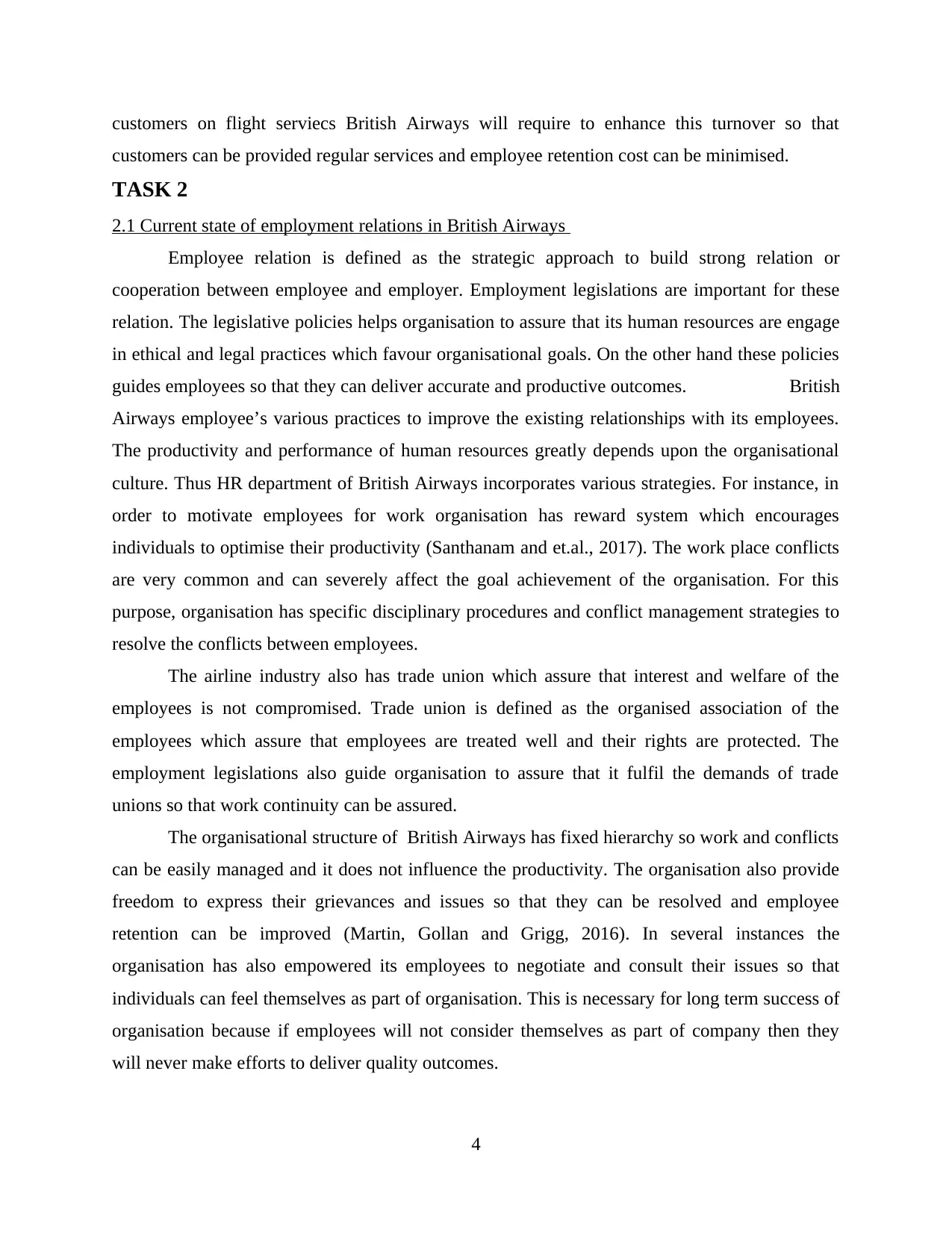
customers on flight serviecs British Airways will require to enhance this turnover so that
customers can be provided regular services and employee retention cost can be minimised.
TASK 2
2.1 Current state of employment relations in British Airways
Employee relation is defined as the strategic approach to build strong relation or
cooperation between employee and employer. Employment legislations are important for these
relation. The legislative policies helps organisation to assure that its human resources are engage
in ethical and legal practices which favour organisational goals. On the other hand these policies
guides employees so that they can deliver accurate and productive outcomes. British
Airways employee’s various practices to improve the existing relationships with its employees.
The productivity and performance of human resources greatly depends upon the organisational
culture. Thus HR department of British Airways incorporates various strategies. For instance, in
order to motivate employees for work organisation has reward system which encourages
individuals to optimise their productivity (Santhanam and et.al., 2017). The work place conflicts
are very common and can severely affect the goal achievement of the organisation. For this
purpose, organisation has specific disciplinary procedures and conflict management strategies to
resolve the conflicts between employees.
The airline industry also has trade union which assure that interest and welfare of the
employees is not compromised. Trade union is defined as the organised association of the
employees which assure that employees are treated well and their rights are protected. The
employment legislations also guide organisation to assure that it fulfil the demands of trade
unions so that work continuity can be assured.
The organisational structure of British Airways has fixed hierarchy so work and conflicts
can be easily managed and it does not influence the productivity. The organisation also provide
freedom to express their grievances and issues so that they can be resolved and employee
retention can be improved (Martin, Gollan and Grigg, 2016). In several instances the
organisation has also empowered its employees to negotiate and consult their issues so that
individuals can feel themselves as part of organisation. This is necessary for long term success of
organisation because if employees will not consider themselves as part of company then they
will never make efforts to deliver quality outcomes.
4
customers can be provided regular services and employee retention cost can be minimised.
TASK 2
2.1 Current state of employment relations in British Airways
Employee relation is defined as the strategic approach to build strong relation or
cooperation between employee and employer. Employment legislations are important for these
relation. The legislative policies helps organisation to assure that its human resources are engage
in ethical and legal practices which favour organisational goals. On the other hand these policies
guides employees so that they can deliver accurate and productive outcomes. British
Airways employee’s various practices to improve the existing relationships with its employees.
The productivity and performance of human resources greatly depends upon the organisational
culture. Thus HR department of British Airways incorporates various strategies. For instance, in
order to motivate employees for work organisation has reward system which encourages
individuals to optimise their productivity (Santhanam and et.al., 2017). The work place conflicts
are very common and can severely affect the goal achievement of the organisation. For this
purpose, organisation has specific disciplinary procedures and conflict management strategies to
resolve the conflicts between employees.
The airline industry also has trade union which assure that interest and welfare of the
employees is not compromised. Trade union is defined as the organised association of the
employees which assure that employees are treated well and their rights are protected. The
employment legislations also guide organisation to assure that it fulfil the demands of trade
unions so that work continuity can be assured.
The organisational structure of British Airways has fixed hierarchy so work and conflicts
can be easily managed and it does not influence the productivity. The organisation also provide
freedom to express their grievances and issues so that they can be resolved and employee
retention can be improved (Martin, Gollan and Grigg, 2016). In several instances the
organisation has also empowered its employees to negotiate and consult their issues so that
individuals can feel themselves as part of organisation. This is necessary for long term success of
organisation because if employees will not consider themselves as part of company then they
will never make efforts to deliver quality outcomes.
4
⊘ This is a preview!⊘
Do you want full access?
Subscribe today to unlock all pages.

Trusted by 1+ million students worldwide
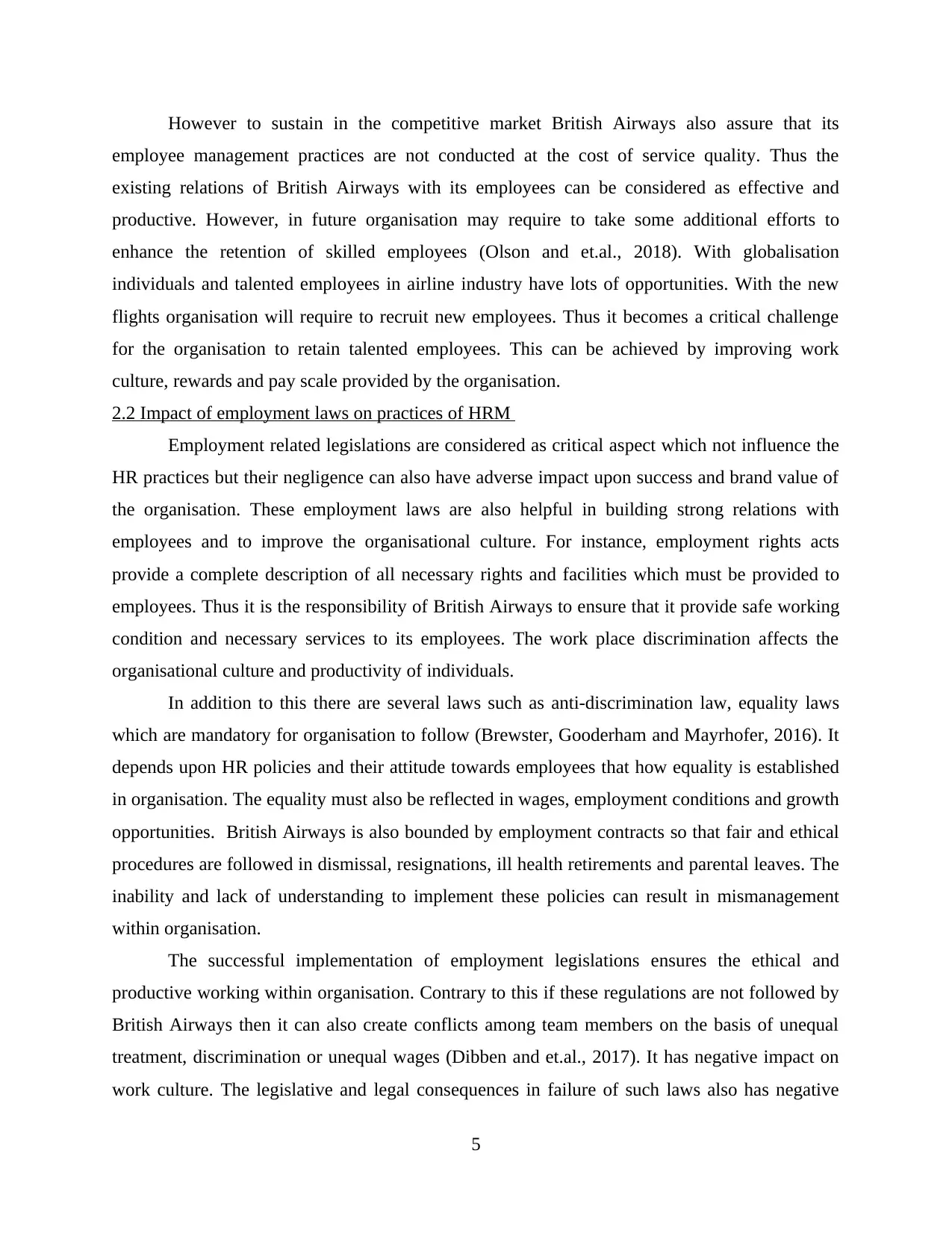
However to sustain in the competitive market British Airways also assure that its
employee management practices are not conducted at the cost of service quality. Thus the
existing relations of British Airways with its employees can be considered as effective and
productive. However, in future organisation may require to take some additional efforts to
enhance the retention of skilled employees (Olson and et.al., 2018). With globalisation
individuals and talented employees in airline industry have lots of opportunities. With the new
flights organisation will require to recruit new employees. Thus it becomes a critical challenge
for the organisation to retain talented employees. This can be achieved by improving work
culture, rewards and pay scale provided by the organisation.
2.2 Impact of employment laws on practices of HRM
Employment related legislations are considered as critical aspect which not influence the
HR practices but their negligence can also have adverse impact upon success and brand value of
the organisation. These employment laws are also helpful in building strong relations with
employees and to improve the organisational culture. For instance, employment rights acts
provide a complete description of all necessary rights and facilities which must be provided to
employees. Thus it is the responsibility of British Airways to ensure that it provide safe working
condition and necessary services to its employees. The work place discrimination affects the
organisational culture and productivity of individuals.
In addition to this there are several laws such as anti-discrimination law, equality laws
which are mandatory for organisation to follow (Brewster, Gooderham and Mayrhofer, 2016). It
depends upon HR policies and their attitude towards employees that how equality is established
in organisation. The equality must also be reflected in wages, employment conditions and growth
opportunities. British Airways is also bounded by employment contracts so that fair and ethical
procedures are followed in dismissal, resignations, ill health retirements and parental leaves. The
inability and lack of understanding to implement these policies can result in mismanagement
within organisation.
The successful implementation of employment legislations ensures the ethical and
productive working within organisation. Contrary to this if these regulations are not followed by
British Airways then it can also create conflicts among team members on the basis of unequal
treatment, discrimination or unequal wages (Dibben and et.al., 2017). It has negative impact on
work culture. The legislative and legal consequences in failure of such laws also has negative
5
employee management practices are not conducted at the cost of service quality. Thus the
existing relations of British Airways with its employees can be considered as effective and
productive. However, in future organisation may require to take some additional efforts to
enhance the retention of skilled employees (Olson and et.al., 2018). With globalisation
individuals and talented employees in airline industry have lots of opportunities. With the new
flights organisation will require to recruit new employees. Thus it becomes a critical challenge
for the organisation to retain talented employees. This can be achieved by improving work
culture, rewards and pay scale provided by the organisation.
2.2 Impact of employment laws on practices of HRM
Employment related legislations are considered as critical aspect which not influence the
HR practices but their negligence can also have adverse impact upon success and brand value of
the organisation. These employment laws are also helpful in building strong relations with
employees and to improve the organisational culture. For instance, employment rights acts
provide a complete description of all necessary rights and facilities which must be provided to
employees. Thus it is the responsibility of British Airways to ensure that it provide safe working
condition and necessary services to its employees. The work place discrimination affects the
organisational culture and productivity of individuals.
In addition to this there are several laws such as anti-discrimination law, equality laws
which are mandatory for organisation to follow (Brewster, Gooderham and Mayrhofer, 2016). It
depends upon HR policies and their attitude towards employees that how equality is established
in organisation. The equality must also be reflected in wages, employment conditions and growth
opportunities. British Airways is also bounded by employment contracts so that fair and ethical
procedures are followed in dismissal, resignations, ill health retirements and parental leaves. The
inability and lack of understanding to implement these policies can result in mismanagement
within organisation.
The successful implementation of employment legislations ensures the ethical and
productive working within organisation. Contrary to this if these regulations are not followed by
British Airways then it can also create conflicts among team members on the basis of unequal
treatment, discrimination or unequal wages (Dibben and et.al., 2017). It has negative impact on
work culture. The legislative and legal consequences in failure of such laws also has negative
5
Paraphrase This Document
Need a fresh take? Get an instant paraphrase of this document with our AI Paraphraser
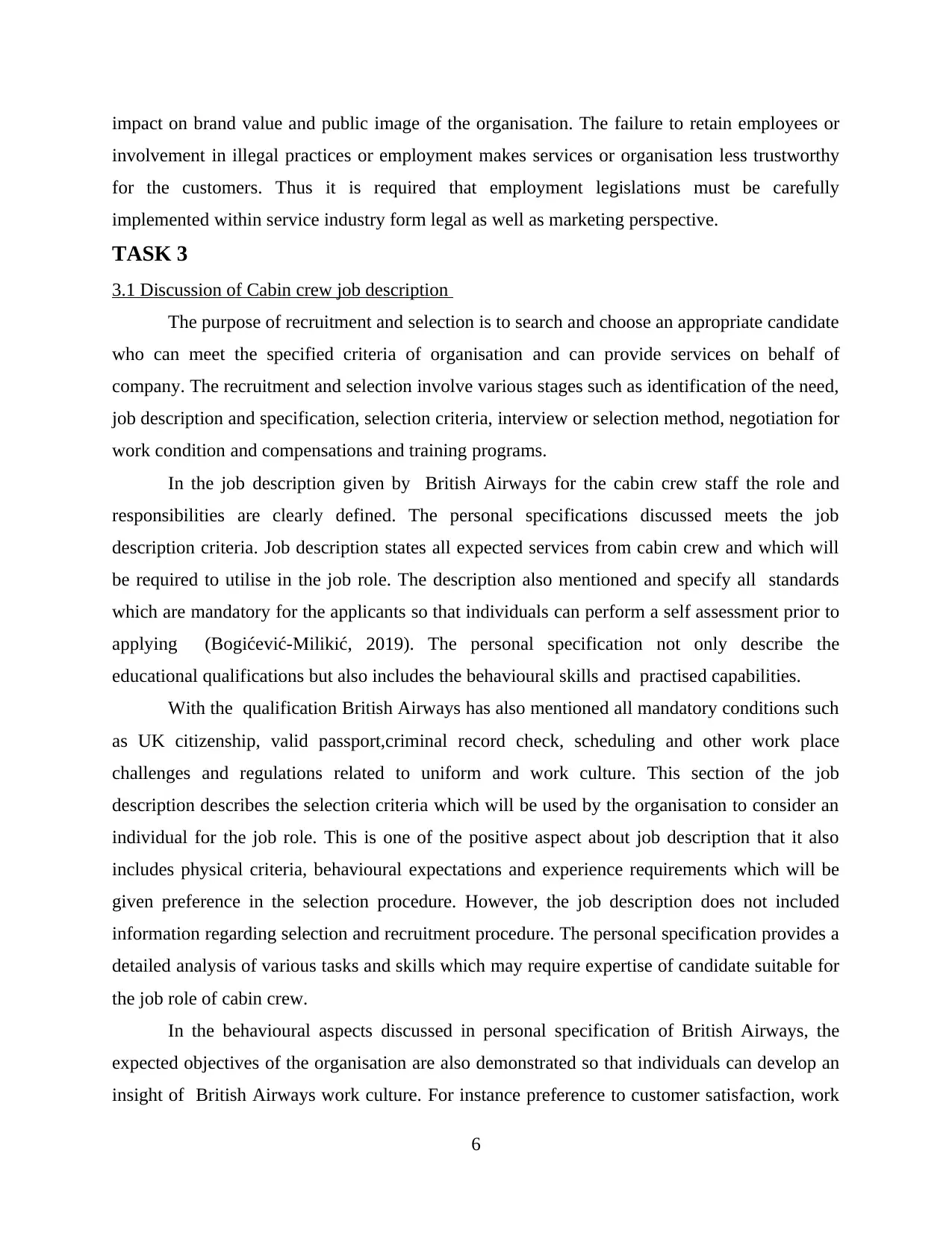
impact on brand value and public image of the organisation. The failure to retain employees or
involvement in illegal practices or employment makes services or organisation less trustworthy
for the customers. Thus it is required that employment legislations must be carefully
implemented within service industry form legal as well as marketing perspective.
TASK 3
3.1 Discussion of Cabin crew job description
The purpose of recruitment and selection is to search and choose an appropriate candidate
who can meet the specified criteria of organisation and can provide services on behalf of
company. The recruitment and selection involve various stages such as identification of the need,
job description and specification, selection criteria, interview or selection method, negotiation for
work condition and compensations and training programs.
In the job description given by British Airways for the cabin crew staff the role and
responsibilities are clearly defined. The personal specifications discussed meets the job
description criteria. Job description states all expected services from cabin crew and which will
be required to utilise in the job role. The description also mentioned and specify all standards
which are mandatory for the applicants so that individuals can perform a self assessment prior to
applying (Bogićević-Milikić, 2019). The personal specification not only describe the
educational qualifications but also includes the behavioural skills and practised capabilities.
With the qualification British Airways has also mentioned all mandatory conditions such
as UK citizenship, valid passport,criminal record check, scheduling and other work place
challenges and regulations related to uniform and work culture. This section of the job
description describes the selection criteria which will be used by the organisation to consider an
individual for the job role. This is one of the positive aspect about job description that it also
includes physical criteria, behavioural expectations and experience requirements which will be
given preference in the selection procedure. However, the job description does not included
information regarding selection and recruitment procedure. The personal specification provides a
detailed analysis of various tasks and skills which may require expertise of candidate suitable for
the job role of cabin crew.
In the behavioural aspects discussed in personal specification of British Airways, the
expected objectives of the organisation are also demonstrated so that individuals can develop an
insight of British Airways work culture. For instance preference to customer satisfaction, work
6
involvement in illegal practices or employment makes services or organisation less trustworthy
for the customers. Thus it is required that employment legislations must be carefully
implemented within service industry form legal as well as marketing perspective.
TASK 3
3.1 Discussion of Cabin crew job description
The purpose of recruitment and selection is to search and choose an appropriate candidate
who can meet the specified criteria of organisation and can provide services on behalf of
company. The recruitment and selection involve various stages such as identification of the need,
job description and specification, selection criteria, interview or selection method, negotiation for
work condition and compensations and training programs.
In the job description given by British Airways for the cabin crew staff the role and
responsibilities are clearly defined. The personal specifications discussed meets the job
description criteria. Job description states all expected services from cabin crew and which will
be required to utilise in the job role. The description also mentioned and specify all standards
which are mandatory for the applicants so that individuals can perform a self assessment prior to
applying (Bogićević-Milikić, 2019). The personal specification not only describe the
educational qualifications but also includes the behavioural skills and practised capabilities.
With the qualification British Airways has also mentioned all mandatory conditions such
as UK citizenship, valid passport,criminal record check, scheduling and other work place
challenges and regulations related to uniform and work culture. This section of the job
description describes the selection criteria which will be used by the organisation to consider an
individual for the job role. This is one of the positive aspect about job description that it also
includes physical criteria, behavioural expectations and experience requirements which will be
given preference in the selection procedure. However, the job description does not included
information regarding selection and recruitment procedure. The personal specification provides a
detailed analysis of various tasks and skills which may require expertise of candidate suitable for
the job role of cabin crew.
In the behavioural aspects discussed in personal specification of British Airways, the
expected objectives of the organisation are also demonstrated so that individuals can develop an
insight of British Airways work culture. For instance preference to customer satisfaction, work
6
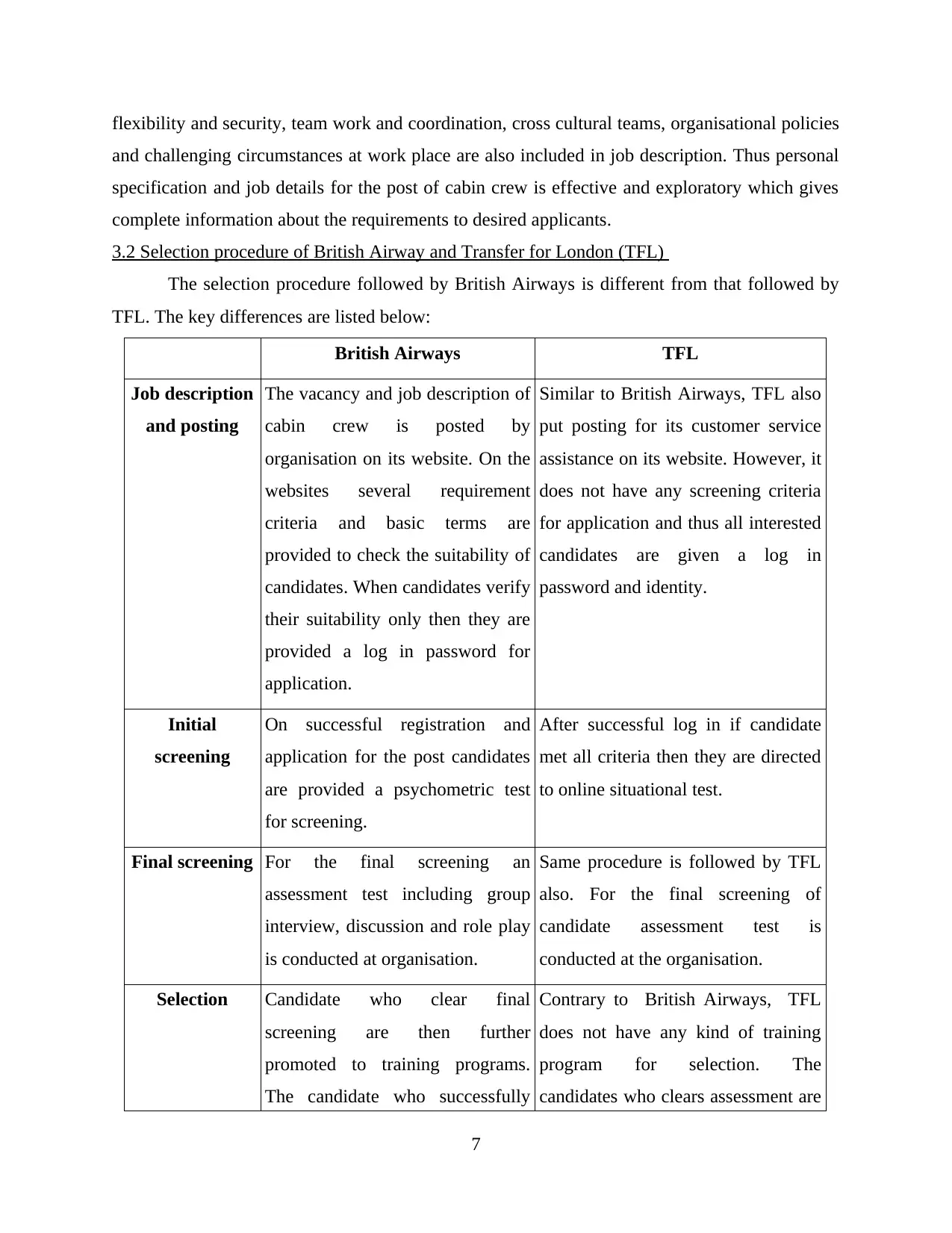
flexibility and security, team work and coordination, cross cultural teams, organisational policies
and challenging circumstances at work place are also included in job description. Thus personal
specification and job details for the post of cabin crew is effective and exploratory which gives
complete information about the requirements to desired applicants.
3.2 Selection procedure of British Airway and Transfer for London (TFL)
The selection procedure followed by British Airways is different from that followed by
TFL. The key differences are listed below:
British Airways TFL
Job description
and posting
The vacancy and job description of
cabin crew is posted by
organisation on its website. On the
websites several requirement
criteria and basic terms are
provided to check the suitability of
candidates. When candidates verify
their suitability only then they are
provided a log in password for
application.
Similar to British Airways, TFL also
put posting for its customer service
assistance on its website. However, it
does not have any screening criteria
for application and thus all interested
candidates are given a log in
password and identity.
Initial
screening
On successful registration and
application for the post candidates
are provided a psychometric test
for screening.
After successful log in if candidate
met all criteria then they are directed
to online situational test.
Final screening For the final screening an
assessment test including group
interview, discussion and role play
is conducted at organisation.
Same procedure is followed by TFL
also. For the final screening of
candidate assessment test is
conducted at the organisation.
Selection Candidate who clear final
screening are then further
promoted to training programs.
The candidate who successfully
Contrary to British Airways, TFL
does not have any kind of training
program for selection. The
candidates who clears assessment are
7
and challenging circumstances at work place are also included in job description. Thus personal
specification and job details for the post of cabin crew is effective and exploratory which gives
complete information about the requirements to desired applicants.
3.2 Selection procedure of British Airway and Transfer for London (TFL)
The selection procedure followed by British Airways is different from that followed by
TFL. The key differences are listed below:
British Airways TFL
Job description
and posting
The vacancy and job description of
cabin crew is posted by
organisation on its website. On the
websites several requirement
criteria and basic terms are
provided to check the suitability of
candidates. When candidates verify
their suitability only then they are
provided a log in password for
application.
Similar to British Airways, TFL also
put posting for its customer service
assistance on its website. However, it
does not have any screening criteria
for application and thus all interested
candidates are given a log in
password and identity.
Initial
screening
On successful registration and
application for the post candidates
are provided a psychometric test
for screening.
After successful log in if candidate
met all criteria then they are directed
to online situational test.
Final screening For the final screening an
assessment test including group
interview, discussion and role play
is conducted at organisation.
Same procedure is followed by TFL
also. For the final screening of
candidate assessment test is
conducted at the organisation.
Selection Candidate who clear final
screening are then further
promoted to training programs.
The candidate who successfully
Contrary to British Airways, TFL
does not have any kind of training
program for selection. The
candidates who clears assessment are
7
⊘ This is a preview!⊘
Do you want full access?
Subscribe today to unlock all pages.

Trusted by 1+ million students worldwide
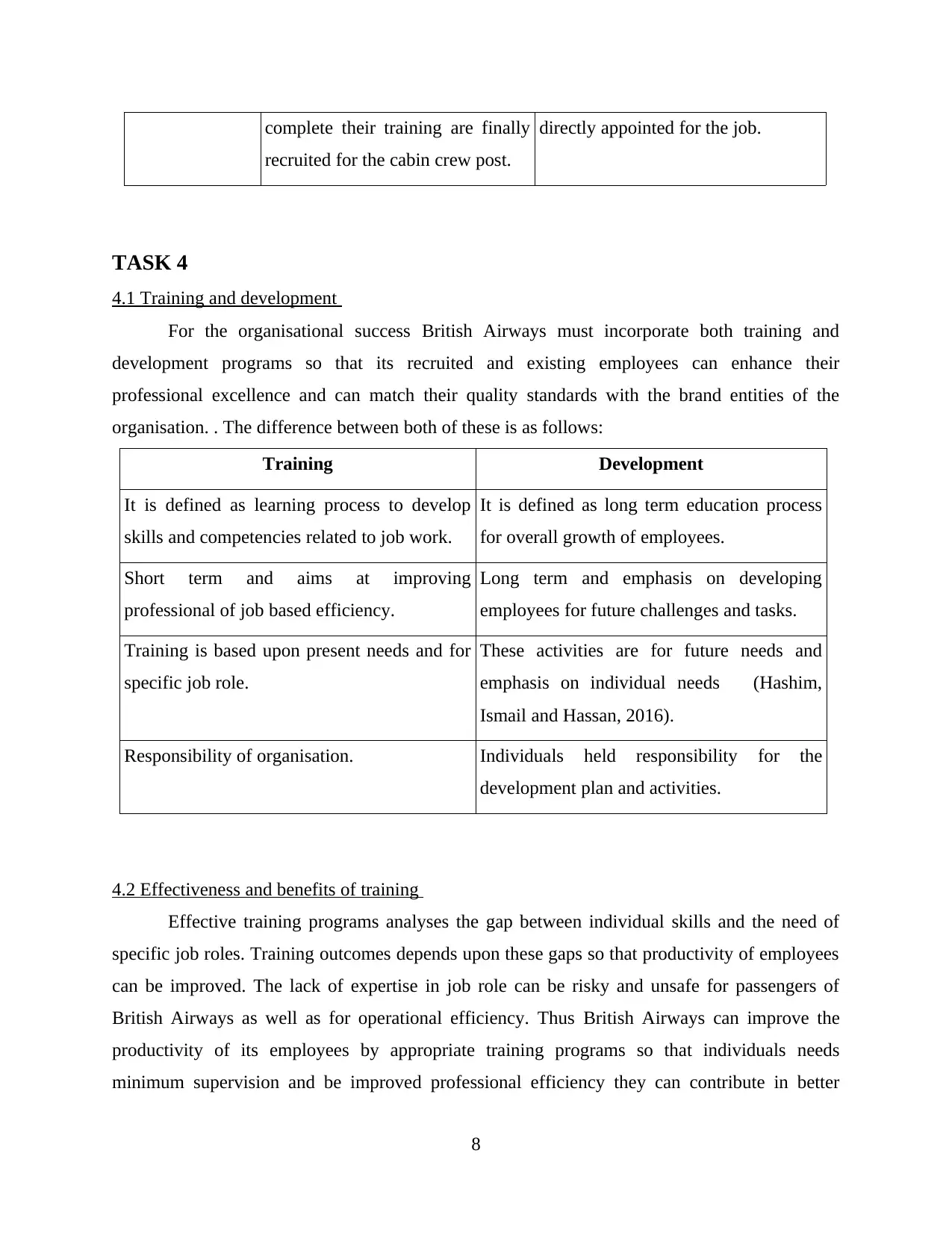
complete their training are finally
recruited for the cabin crew post.
directly appointed for the job.
TASK 4
4.1 Training and development
For the organisational success British Airways must incorporate both training and
development programs so that its recruited and existing employees can enhance their
professional excellence and can match their quality standards with the brand entities of the
organisation. . The difference between both of these is as follows:
Training Development
It is defined as learning process to develop
skills and competencies related to job work.
It is defined as long term education process
for overall growth of employees.
Short term and aims at improving
professional of job based efficiency.
Long term and emphasis on developing
employees for future challenges and tasks.
Training is based upon present needs and for
specific job role.
These activities are for future needs and
emphasis on individual needs (Hashim,
Ismail and Hassan, 2016).
Responsibility of organisation. Individuals held responsibility for the
development plan and activities.
4.2 Effectiveness and benefits of training
Effective training programs analyses the gap between individual skills and the need of
specific job roles. Training outcomes depends upon these gaps so that productivity of employees
can be improved. The lack of expertise in job role can be risky and unsafe for passengers of
British Airways as well as for operational efficiency. Thus British Airways can improve the
productivity of its employees by appropriate training programs so that individuals needs
minimum supervision and be improved professional efficiency they can contribute in better
8
recruited for the cabin crew post.
directly appointed for the job.
TASK 4
4.1 Training and development
For the organisational success British Airways must incorporate both training and
development programs so that its recruited and existing employees can enhance their
professional excellence and can match their quality standards with the brand entities of the
organisation. . The difference between both of these is as follows:
Training Development
It is defined as learning process to develop
skills and competencies related to job work.
It is defined as long term education process
for overall growth of employees.
Short term and aims at improving
professional of job based efficiency.
Long term and emphasis on developing
employees for future challenges and tasks.
Training is based upon present needs and for
specific job role.
These activities are for future needs and
emphasis on individual needs (Hashim,
Ismail and Hassan, 2016).
Responsibility of organisation. Individuals held responsibility for the
development plan and activities.
4.2 Effectiveness and benefits of training
Effective training programs analyses the gap between individual skills and the need of
specific job roles. Training outcomes depends upon these gaps so that productivity of employees
can be improved. The lack of expertise in job role can be risky and unsafe for passengers of
British Airways as well as for operational efficiency. Thus British Airways can improve the
productivity of its employees by appropriate training programs so that individuals needs
minimum supervision and be improved professional efficiency they can contribute in better
8
Paraphrase This Document
Need a fresh take? Get an instant paraphrase of this document with our AI Paraphraser
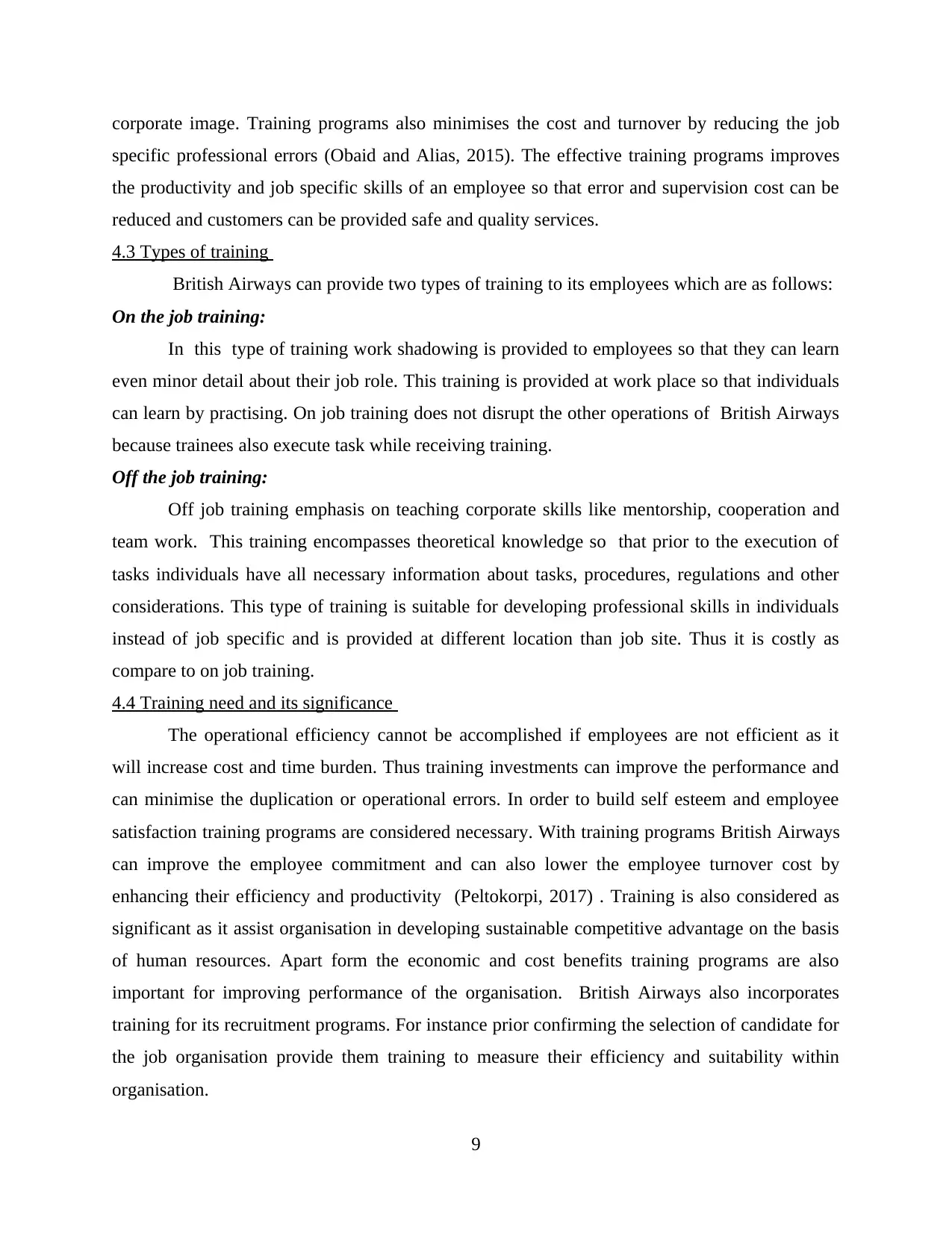
corporate image. Training programs also minimises the cost and turnover by reducing the job
specific professional errors (Obaid and Alias, 2015). The effective training programs improves
the productivity and job specific skills of an employee so that error and supervision cost can be
reduced and customers can be provided safe and quality services.
4.3 Types of training
British Airways can provide two types of training to its employees which are as follows:
On the job training:
In this type of training work shadowing is provided to employees so that they can learn
even minor detail about their job role. This training is provided at work place so that individuals
can learn by practising. On job training does not disrupt the other operations of British Airways
because trainees also execute task while receiving training.
Off the job training:
Off job training emphasis on teaching corporate skills like mentorship, cooperation and
team work. This training encompasses theoretical knowledge so that prior to the execution of
tasks individuals have all necessary information about tasks, procedures, regulations and other
considerations. This type of training is suitable for developing professional skills in individuals
instead of job specific and is provided at different location than job site. Thus it is costly as
compare to on job training.
4.4 Training need and its significance
The operational efficiency cannot be accomplished if employees are not efficient as it
will increase cost and time burden. Thus training investments can improve the performance and
can minimise the duplication or operational errors. In order to build self esteem and employee
satisfaction training programs are considered necessary. With training programs British Airways
can improve the employee commitment and can also lower the employee turnover cost by
enhancing their efficiency and productivity (Peltokorpi, 2017) . Training is also considered as
significant as it assist organisation in developing sustainable competitive advantage on the basis
of human resources. Apart form the economic and cost benefits training programs are also
important for improving performance of the organisation. British Airways also incorporates
training for its recruitment programs. For instance prior confirming the selection of candidate for
the job organisation provide them training to measure their efficiency and suitability within
organisation.
9
specific professional errors (Obaid and Alias, 2015). The effective training programs improves
the productivity and job specific skills of an employee so that error and supervision cost can be
reduced and customers can be provided safe and quality services.
4.3 Types of training
British Airways can provide two types of training to its employees which are as follows:
On the job training:
In this type of training work shadowing is provided to employees so that they can learn
even minor detail about their job role. This training is provided at work place so that individuals
can learn by practising. On job training does not disrupt the other operations of British Airways
because trainees also execute task while receiving training.
Off the job training:
Off job training emphasis on teaching corporate skills like mentorship, cooperation and
team work. This training encompasses theoretical knowledge so that prior to the execution of
tasks individuals have all necessary information about tasks, procedures, regulations and other
considerations. This type of training is suitable for developing professional skills in individuals
instead of job specific and is provided at different location than job site. Thus it is costly as
compare to on job training.
4.4 Training need and its significance
The operational efficiency cannot be accomplished if employees are not efficient as it
will increase cost and time burden. Thus training investments can improve the performance and
can minimise the duplication or operational errors. In order to build self esteem and employee
satisfaction training programs are considered necessary. With training programs British Airways
can improve the employee commitment and can also lower the employee turnover cost by
enhancing their efficiency and productivity (Peltokorpi, 2017) . Training is also considered as
significant as it assist organisation in developing sustainable competitive advantage on the basis
of human resources. Apart form the economic and cost benefits training programs are also
important for improving performance of the organisation. British Airways also incorporates
training for its recruitment programs. For instance prior confirming the selection of candidate for
the job organisation provide them training to measure their efficiency and suitability within
organisation.
9
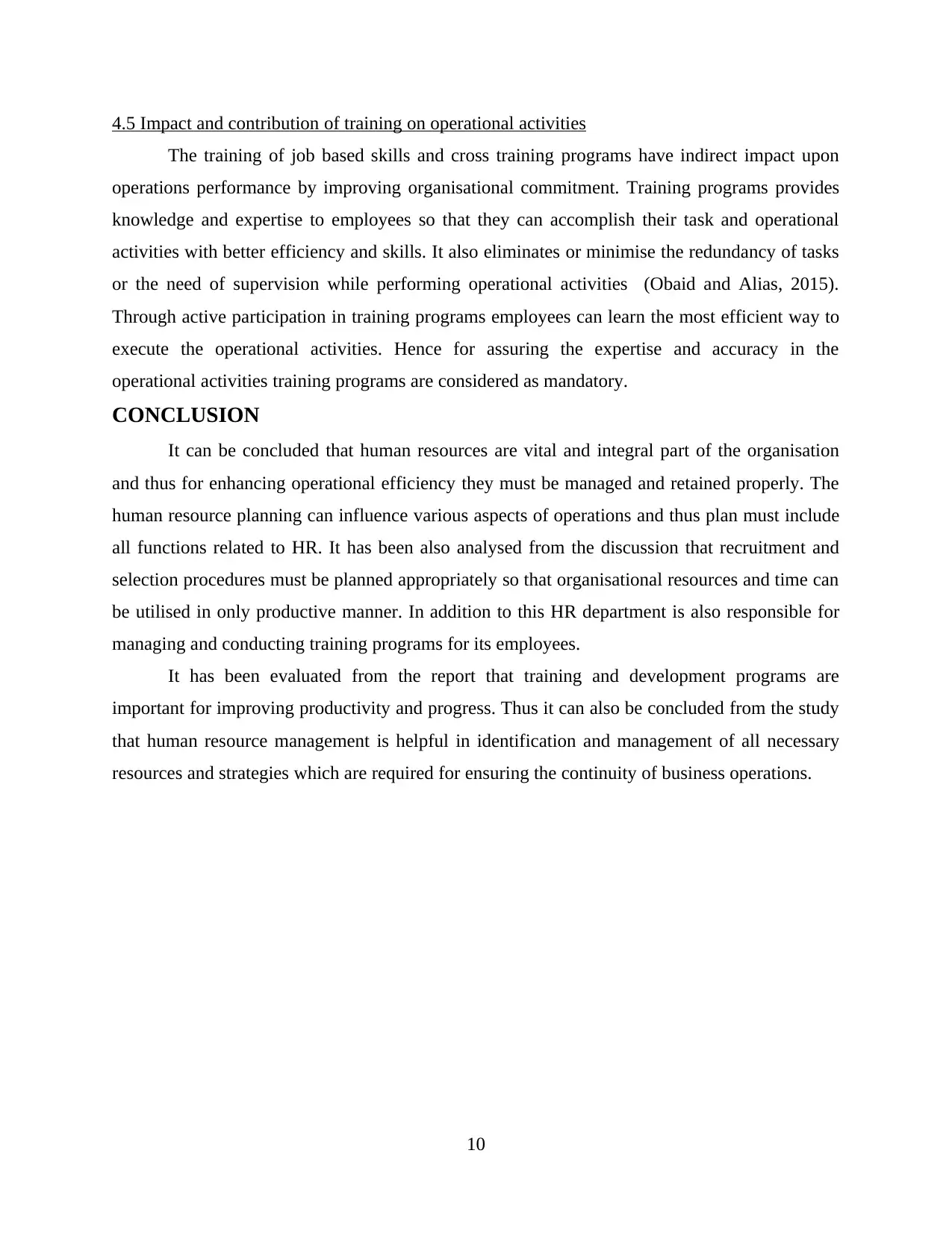
4.5 Impact and contribution of training on operational activities
The training of job based skills and cross training programs have indirect impact upon
operations performance by improving organisational commitment. Training programs provides
knowledge and expertise to employees so that they can accomplish their task and operational
activities with better efficiency and skills. It also eliminates or minimise the redundancy of tasks
or the need of supervision while performing operational activities (Obaid and Alias, 2015).
Through active participation in training programs employees can learn the most efficient way to
execute the operational activities. Hence for assuring the expertise and accuracy in the
operational activities training programs are considered as mandatory.
CONCLUSION
It can be concluded that human resources are vital and integral part of the organisation
and thus for enhancing operational efficiency they must be managed and retained properly. The
human resource planning can influence various aspects of operations and thus plan must include
all functions related to HR. It has been also analysed from the discussion that recruitment and
selection procedures must be planned appropriately so that organisational resources and time can
be utilised in only productive manner. In addition to this HR department is also responsible for
managing and conducting training programs for its employees.
It has been evaluated from the report that training and development programs are
important for improving productivity and progress. Thus it can also be concluded from the study
that human resource management is helpful in identification and management of all necessary
resources and strategies which are required for ensuring the continuity of business operations.
10
The training of job based skills and cross training programs have indirect impact upon
operations performance by improving organisational commitment. Training programs provides
knowledge and expertise to employees so that they can accomplish their task and operational
activities with better efficiency and skills. It also eliminates or minimise the redundancy of tasks
or the need of supervision while performing operational activities (Obaid and Alias, 2015).
Through active participation in training programs employees can learn the most efficient way to
execute the operational activities. Hence for assuring the expertise and accuracy in the
operational activities training programs are considered as mandatory.
CONCLUSION
It can be concluded that human resources are vital and integral part of the organisation
and thus for enhancing operational efficiency they must be managed and retained properly. The
human resource planning can influence various aspects of operations and thus plan must include
all functions related to HR. It has been also analysed from the discussion that recruitment and
selection procedures must be planned appropriately so that organisational resources and time can
be utilised in only productive manner. In addition to this HR department is also responsible for
managing and conducting training programs for its employees.
It has been evaluated from the report that training and development programs are
important for improving productivity and progress. Thus it can also be concluded from the study
that human resource management is helpful in identification and management of all necessary
resources and strategies which are required for ensuring the continuity of business operations.
10
⊘ This is a preview!⊘
Do you want full access?
Subscribe today to unlock all pages.

Trusted by 1+ million students worldwide
1 out of 17
Related Documents
Your All-in-One AI-Powered Toolkit for Academic Success.
+13062052269
info@desklib.com
Available 24*7 on WhatsApp / Email
![[object Object]](/_next/static/media/star-bottom.7253800d.svg)
Unlock your academic potential
Copyright © 2020–2025 A2Z Services. All Rights Reserved. Developed and managed by ZUCOL.



